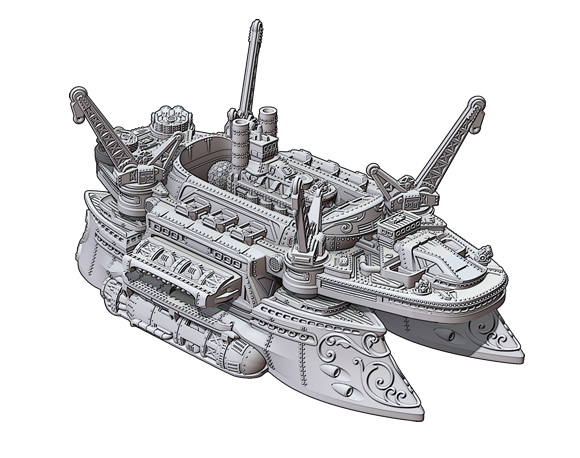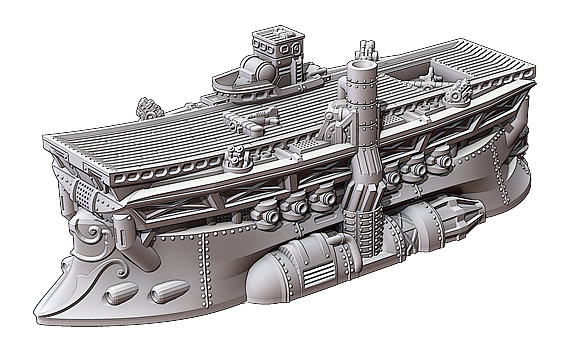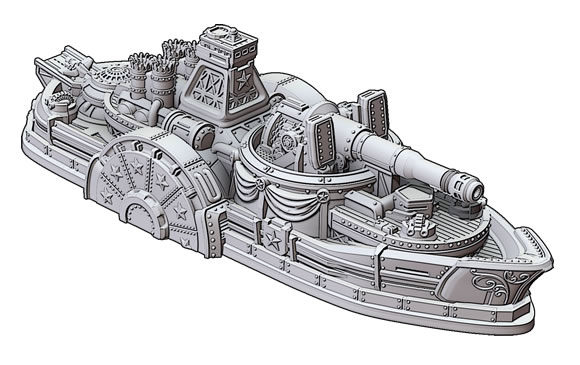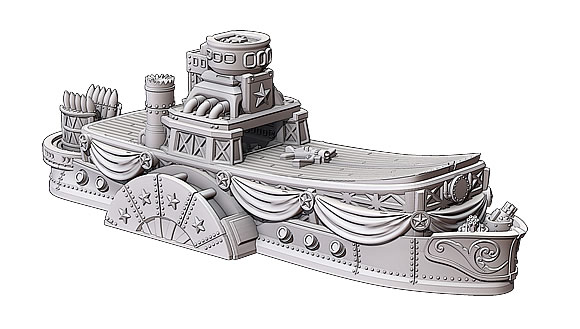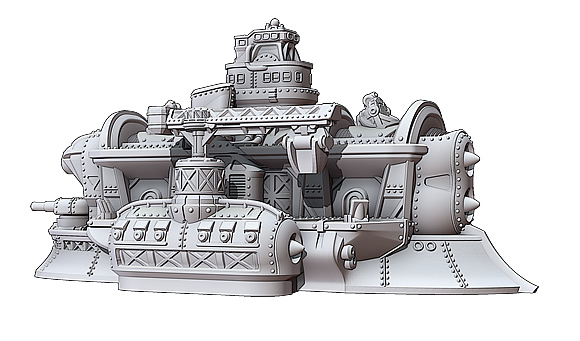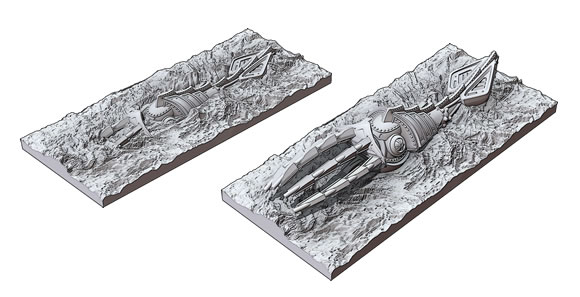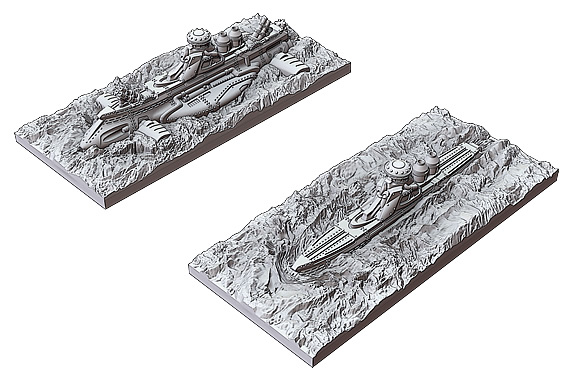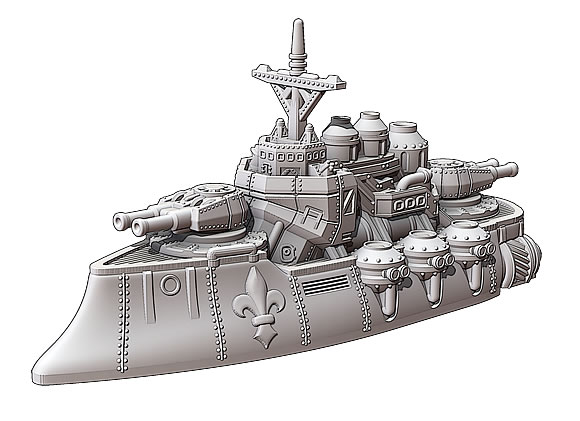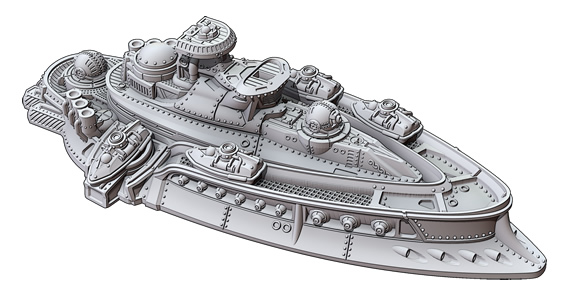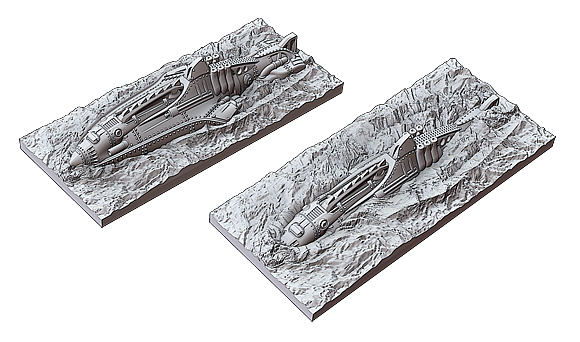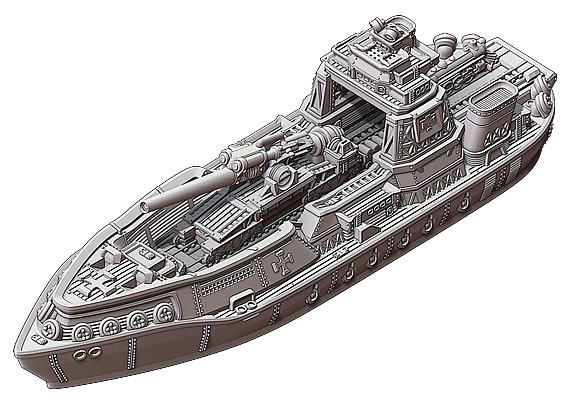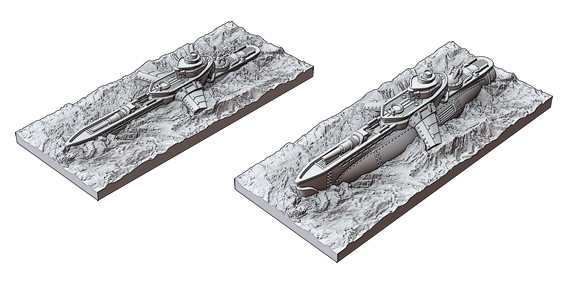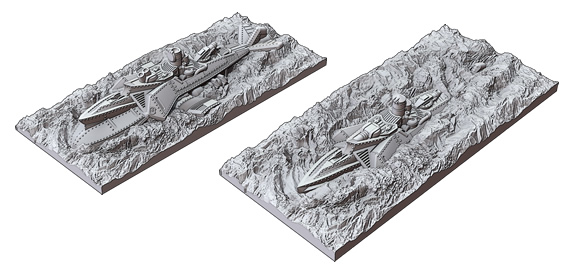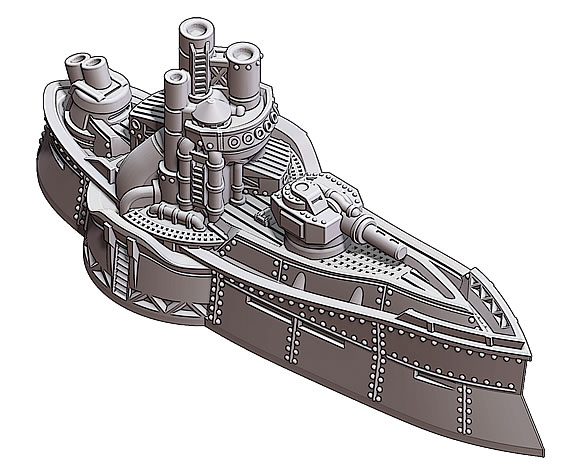
Core Nation Expansion Boxes
Our Core Nation Expansion Boxes are an important part of the Kickstarter Campaign, appealing as they do to many thousands of existing Dystopian Wars players around the world. The new models inside these boxes have been chosen by our rules writers as an important expansion which either adds ‘narrative flavour‘ to an existing fleet or plug a tactical ‘gap’ for that Nation.
The first models we have elected to make are a mix of either Naval or Aerial and the following narrative text and images will bring you up to speed on what we have developed for the Core Seven Nations. We’d heartily recommend that you review this blog as it details over 20 cool new models which are coming your way, models which will bring enhanced capability to your Core Nation and a dose of devastation to your enemies!
Please note that full Squadrons of a model are always included along with any SAS (Flyer) tokens if needed:
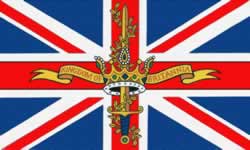 KINGDOM OF BRITANNIA
KINGDOM OF BRITANNIA
Dynasty Class Repair Ship (Large) (Unit size 1)
The Dynasty is a new breed of utility ship created in the dockyards of northern Britain and was designed by the famed shipwright Angus Stevenson on the urgent orders of the Naval Admiralty.
The Naval Armada desired a vessel of ‘supreme ruggedness and permanence’ that could be used to repair and reinforce Britannian fleets operating far from their home base. Armed with this brief the master-shipbuilder galvanised his ideas into the Dynasty, the toughest ship class ever to steam forth from the shipyards of the Clyde.
The Dynasty is a huge engineering platform from which specially trained teams of combat mechanics, equipped with ‘RAT’ rocket packs, launch themselves towards damaged Britannian vessels to conduct vital field repairs. Furthermore, with its powerful wireless systems, a Dynasty can allow for improved coordination between other units in its naval group, and their allies.
A Dynasty is no Battleship, but its capacious lower decks mount some of the most potent torpedo tube arrays of any warship of its size. These are enhanced by an ingenious target painter generator. This device employs an Element 270 powered underwater radiograph, connected to a bank of high-speed difference engines to detect an enemy warship and calculate predictions of speed and movement, allowing for torpedo volleys to be aimed and discharged with greater accuracy.
This ingenious device is also connected to potent wireless system of the Dynasty, allowing other nearby Britannian vessels to benefit from this enhanced targeting. This has led to the Dynasty also becoming famed as a particularly deadly ‘sub-killer’; a very well-regarded innovation given the growing popularity of submersible warships among Britannia’s enemies.
Felshaw Class Light Carrier (Medium) (Unis size 1-2)
The Long Range Naval Group concept was developed in 1873 as a response to the growing threat of enemy raiders to the Kingdom of Britannia’s maritime supply lines, as well as the Naval Armada’s requirement for raiding capacity of its own. Such fast-moving forces needed a high-speed vessel to provide local air cover, yet still mounting enough firepower to defend itself from attack by lighter craft.
The Felshaw Light Carrier, named after Commodore Sir Jack Felshaw who proposed the ‘Cruiser-Carrier’ concept in early 1872, has become vital to the operation of the LRNGs. Its innocuous build and low silhouette makes it easy to conceal from reconnaissance planes prior to launching its air wings.
Mounting broadside batteries of quick-firing 7” guns in trainable casemates, and numerous torpedo launchers, the Felshaw is a tough prospect for Frigates and Corvettes, but even enemy Cruiser and Gunship captains should think twice about attacking a Felshaw while its bomber squadrons are airborne!
Peregrine Class Dive Bomber (Small) (Unit size 2-5)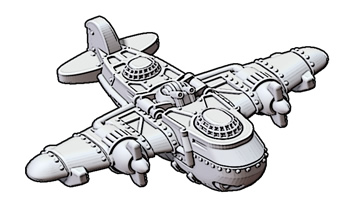 The Peregrine Dive Bomber was based on the Merlin Interceptor, but did not enter service until late 1873 due to the prioritising of the former for home defence. The first examples of the dive bomber saw action in the Caribbean, where they helped reduce the infamous Blazing Sun ‘Korea Gun’ installations on occupied Puerto Rico.
The Peregrine Dive Bomber was based on the Merlin Interceptor, but did not enter service until late 1873 due to the prioritising of the former for home defence. The first examples of the dive bomber saw action in the Caribbean, where they helped reduce the infamous Blazing Sun ‘Korea Gun’ installations on occupied Puerto Rico.
Despite this early success, the design had a somewhat troubled development, with many accidents. The Peregrine is a difficult and temperamental aircraft to fly; quick to punish rough handling by inexperienced pilots. But the spectacle of their howling power dives and deadly accurate bomb strikes make them a firm favourite with Britannian soldiers and sailors, who revel in otherwise resolute enemies scattering before their attacks!
 FEDERATED STATES OF AMERICA
FEDERATED STATES OF AMERICA
Providence Class Bombard Monitor (Large) (Unit size 1)
The Providence Class Bombard Monitor is a product of experience gained by the FSA’s navy in operations across the world in the early part of the World War. Campaigns such as those which took place in the Pacific, where the ability to bombard shore positions from vast ranges became a priority for fleet commanders.
The Providence Class Monitor is built around its massive main battery, the Orlington ‘Big Joe’ Mark 1 repeating howitzer. This huge weapon and its supporting structures occupy almost half the Providence’s hull, but it is well worth the costs. With one firing, this single weapon can discharge a weight of ordnance equivalent to a whole battery of lesser pieces, in a tight grouping for maximum devastation.
The ‘Big Joe’ fires like a peal of thunder, followed by a brief period of unnerving quiet before its terrifying barrage arrives on target all at once. The crews of these vessels call this being ‘touched by the hand of Providence’ and joke that while their enemies rarely see retribution coming their way, they sure as hell can hear it!
Early in the class’s development, FSA army engineers brought back captured examples of French ‘sling-shot’ aircraft launching devices following operations in North Africa. Modified versions were built into the Providence as an experimental measure, and are used for launching aeroplanes without burdening the vessel with a flight deck.
Calico Light Carrier (Medium) (Unit size 1-2)
The Calico Light Carrier is a recent addition to the coastal defence forces of the Federated States. As with many of the vessels fielded by the Americans, the Calico is flexible enough to survive in numerous types of military engagements. It was first built in the shipyards of California, providing patrol fleets with long-range air cover against Blazing Sun raiding forces that periodically attacked coastal targets on the FSA’s long Latin American seaboard.
Though mainly intended for carrier support duties, the Calico was designed with a high degree of adaptability in mind, with a tried and tested ‘Universal’ mounting capable of holding a variety of payloads. The standard Scott-Packard rocket battery gives it an edge in bombardment operations.
To Bunt or Not to Bunt…that is the question! We have two versions of the Calico – one with added bunting detailing and one without.
This can be replaced with a Jonesville Kinetic accelerator for vessels operating in the pursuit, raiding or even boarding assault role with their sizeable Marine Corps complement; or a Westmoreland ‘Little Rock’ standard shield projector – the latter turning the Calico into a tough close-defence vessel for Cruiser squadrons when its formidable volley-gun batteries are brought into play.
Animas Class Attack Submarine (Small) (Unit size 2-4)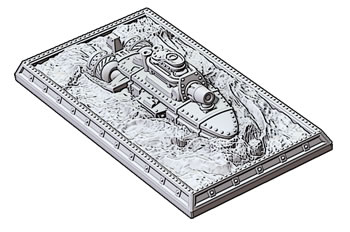 The FSA learnt much from the Operation: Shadow Hunter military campaign and the Animas Class Attack Submarine is part of that legacy. It provides the Federated States of America with another aggressive boarding threat that lurks beneath the waves.
The FSA learnt much from the Operation: Shadow Hunter military campaign and the Animas Class Attack Submarine is part of that legacy. It provides the Federated States of America with another aggressive boarding threat that lurks beneath the waves.
Armed with a solid fore cannon and crewed with some of the more ‘independently minded’ members of the Federated States’ vaunted Marine Corps, the submarine excels in getting close and causing havoc amongst enemy vessels. Frequently painted black or dark blue, the Animas is often used in night attacks against enemy warships at anchor, where a few determined bands of men with automatic weapons and limpet mines can create as much panic as a full naval bombardment!
 EMPIRE OF THE BLAZING SUN
EMPIRE OF THE BLAZING SUN
Toyokawa Repair Vessel (Large) (Unit size 1)
The designers of this vessel turned to Yoshiro Nagsumi’s ubiquitous Battleship hull that has become the cornerstone of Japanese design for the last decade. Originally created to repair ships damaged by the seasonal hurricanes that plague the Japanese coasts, the Toyokawa later became a firm favourite with Commodores who recognised its effectiveness during protracted military campaigns in distant regions.
It is no surprise that, following the Blazing Sun’s expansion of Kanawa Province in South America in 1875 that Toyokawas immediately began taking shape in its shipyards. The rugged design makes it almost unsinkable, and their captains take unprecedented risks to reach and repair stricken Blazing Sun vessels, whether beset by fierce Sturginium Age storms or enemy attack.
The sight of a Toyokawa sailing towards a stricken Blazing Sun vessel is said to “calm the souls of crews”, and the sailors of the Three Armies regard them as blessed ships. For enemy seafarers, however, the exact opposite is true.
With a quick-firing turret, ferocious broadside batteries of rocket-assisted cannons, and torpedoes to the fore, this sturdy support vessel can fight off a squadron of lesser foes threatening ships under its protection. And if the enemy seeks to nullify this potent firepower by braving a boarding assault, the Toyokawa’s massed complement of Tsunami Rocket Corps Samurai will soon make them regret their rashness.
Chita Class Robot Submarine (Medium) (Unit size 1-2)
Ever since the Imperial Alchemical Institute first perfected the monstrous Ika at its secretive research bases on Tsushima Island, its maritime researchers have continued to produce ferocious mechanical sea creatures to serve in the Empress’s fleets.
The Chita is their latest invention. Equipped with ‘wrapping’ tentacles that can lock to paralyse its target, this ferocious robotic squid burns its prey with terrifying gouts of alchemical fire, chemical brews that blaze fiercely even in water, before dragging it beneath the waves to be torn apart.
All mariners have an innate fear of being consumed by the denizens of the deep, and the Blazing Sun’s naval forces now have a whole plethora of tools to frighten enemy sailors with this grim fate. The otherwise placid waters near any Blazing Sun territory are now sure to conceal deadly secrets!
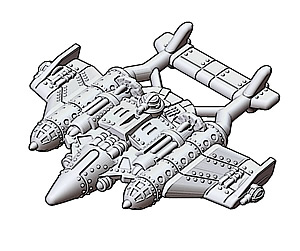 Obu Class Strike Bomber (Small) (Unit size 2-5)
Obu Class Strike Bomber (Small) (Unit size 2-5)
The Obu is an offshoot of the same aeronautical plan that produced the tested Tetsubo strike aeroplane. Where the Tetsubo was developed to deploy gas weaponry, the Obu was built around a more conventional payload. Gas, while effective, is unpredictable. The Sword Army pushed for the development of the Obu, with High General Uematsu and his subordinates favouring the sure strike of explosive ordnance, especially against hard targets.
The Obu’s core airframe is virtually all bomb bay, with the rest of its bulk being mainly devoted to its powerful engines. With high speed and surprisingly long range, the first examples saw much use in the island skirmishes of the East Indies towards the end of 1873. Lightly built, the Obu is a very forgiving and agile aircraft to fly, and its deadly firebombs provide a potent punch against any surface target, even when dropped from level flight.
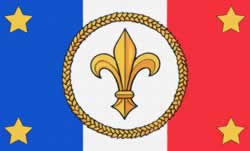 RÉPUBLIQUE OF FRANCE
RÉPUBLIQUE OF FRANCE
Marans Bombardment Submarine (Large) (Unit size 1)
The French naval forces pioneered the use of submarine-mounted artillery, with their diminutive Epaulard Class. Although this small craft gave sterling service in the early part of the World War, by the beginning of 1874, French naval architects decided to develop the concept into something much more deadly for when the World War inevitably flared up into a full-scale conflagration again.
The Marans was developed in a secure dockyard at Toulon as a true submarine Battleship, an elegant but deadly design. A pair of rotary mortars equipped with lethal acid munitions form the main armament for attacking enemy formations and installations from a considerable distance. A sizeable torpedo array was fitted for anti-shipping operations, while floating mine-dischargers aft complete its powerful weaponry.
The vessel was purposely designed to be able to compromise entire enemy harbours, with the well-defended ports of the southern British Isles a key target. Attacking by stealth, chemical bombardments would reduce shore targets, while torpedo volleys play havoc with anchored shipping. As a final blow, harbour entrances would be seeded with mines to delay pursuit and cause a continuing hazard to all operations.
The first Marans went into action in early 1874, as part of an interdiction force in a raid on Gibraltar. Although the attack was only of short duration, the submarine caused considerable disruption to the ongoing attempts to rebuild the base, its mines still claiming merchantman victims several weeks after the operation.
Royan Class Gunship (Medium) (Unit size 2-3)
As part of the ongoing development of their Naval Legion fleets, the French General Staff considered the need to strengthen the forces shielding France’s long Atlantic coastline to be a priority, as well as giving them more means to strike at Grand Coalition shipping routes.
The Royan Gunship was developed in the waning months of 1873, as the first phase of major war operations began to die down, and offensive patrols and commerce raiding became more widespread. Designed for long-range operations, and easier to maintain than the Heat-Lance armed Toulon Class, it relies upon conventional firepower to bring down its opponents.
Though short-ranged, its combination of turret and broadside ordnance can overwhelm all but the most powerful opponents. These vessels also boast a strong complement of Marines to contest boarding actions and serve as prize crews, for the French prefer to capture enemy vessels as spoils of war wherever possible. The appearance of the Royan has made the Bay of Biscay and Celtic Sea even more dangerous for Grand Coalition shipping, and every loss is to France’s gain.
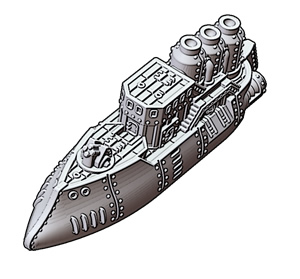 Bayone Escort (Small) (6 models supplied)
Bayone Escort (Small) (6 models supplied)
The French have long been aware of the threat of underwater attack, with many bitter experiences at the hands of Britannian submariners in particular. It was therefore inevitable that French naval designers would be commissioned to create a specialist anti-submarine escort vessel.
The course they chose was to re-engineer the trusty Bayone Class. Now carrying a larger complement of Marines, and with a greater capacity for concussion charge launchers, groups of these small ships are a substantial hazard to enemy submersibles and foes over-reliant on torpedo attacks.
 COVENANT OF ANTARCTICA
COVENANT OF ANTARCTICA
Menedaius Support Ship (Large) (Unit size 1)
The Menedaius Support Ship came into service with the Covenant War and Interdiction Fleets in early 1874, after the near total abandonment of long-range translocation attacks. With the need for conventional support on distant missions and stations, Covenant shipwrights redeveloped the Pericles hull into a dedicated fleet support vessel.
The most remarkable aspect of the Menedaius is that it serves as a mobile docking rig for remote fleet repair craft, and saw the Newton Class vessel developed alongside it. The swift Newtons carry special teams of engineers and Controllers overseeing teams of Iron Man artificers to damaged Covenant vessels, even those distant from their mothership.
With compact Sturginium steam pressure-engines providing power, the Menedaius has room to pack a credible amount of weaponry. Like most large Antarctican vessels, its main battery is interchangeable, and can mount either rapid-fire multiple cannons or energy-beam projectors. Together with typically long range Covenant torpedoes, a Menedaius provides considerable supporting firepower at long range. Its tough outer hull is also studded with semi-automatic gun-blisters for close defence.
As with most Covenant craft, the crew complement is very small for a vessel of its size, controlling most of the ship’s functions remotely from well protected positions deep within the hull. The majority are scientists and engineers, not soldiers, and must rely heavily on armour protection and automated defences in the event of enemy boarding attempts. However, for the enemy to even get that close through the inevitable storm of firepower is not a common occurrence!
Newton Repair Ship (multiple bases supplied)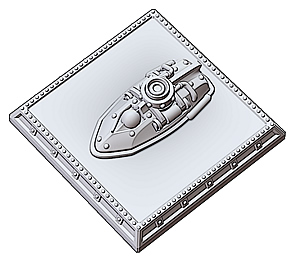 Carried in squadrons aboard the huge Menedaius Class, the Newton Repair Ship is an exciting innovation for the Covenant Fleets, providing an effective and responsive remote repair function to the battle line.
Carried in squadrons aboard the huge Menedaius Class, the Newton Repair Ship is an exciting innovation for the Covenant Fleets, providing an effective and responsive remote repair function to the battle line.
Housed within the tiny vessel’s confines are a plethora of engineering crew capable of jetting towards the target ship to perform daring repair jobs while under fire. The human crews are accompanied by Iron Men to handle heavy labour, allowing these small complements of specialists to perform extensive and complex repairs in record time.
Praxilla Hunter Killer Submarine (Medium) (Unit size 1-2)
Praxilla is one of the newest ships, and concepts, to appear in the Covenant naval forces. Developed in the aftermath of the stinging American assault on the ‘ghost island’ Hooke’s Reach in 1872, the Praxilla is, in the words of its designer, Shipwright-Primus Amberley Hawtin, ‘a floating assassin’.
The shark like submersible is a true hunter-killer, a seaborne archer of cruel efficiency. Its primary weaponry is a lethal ‘Long Lance’ magnetic impeller, capable of hurling metal darts at huge velocities, sufficient to smash through the toughest armour. A group of Praxillas often seek to triangulate their fire, performing a massive, deadly precision strike on key enemy target before slipping beneath the waves.
Though less at home at short range, with a crew of no more than twenty-five, the submersible is by no means defenceless. In-built luminescent designators allow the vessel to mark targets for destruction by other Covenant units, and an overconfident enemy crew can quickly find their ship flayed to red-hot scrap by a criss-crossing web of killing light beams. Neither is it a particularly easy prospect for opportunistic boarding attempts, as it also carries a complement of Iron Men automata aboard.
Theon Light Interceptor (Small) (Unit size 2-4)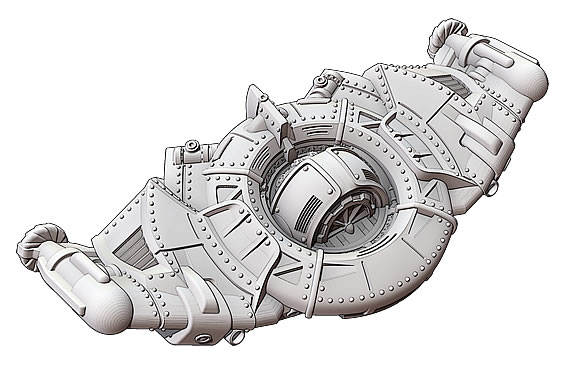 Although Covenant air power is still heavily reliant on semi-expendable drones remotely controlled from large mother-vessels, manned aircraft still have a place in Covenant orders of battle. This is especially so in the arena of straight-up aerial combat, where skilled human pilots can often get the better of drone aeroplanes with relative ease.
Although Covenant air power is still heavily reliant on semi-expendable drones remotely controlled from large mother-vessels, manned aircraft still have a place in Covenant orders of battle. This is especially so in the arena of straight-up aerial combat, where skilled human pilots can often get the better of drone aeroplanes with relative ease.
The Theon was another product of Covenant military development following the defence of Hooke’s Reach and the Petropavlovsk Raid. Another ingenious airframe reliant on rotor-fan propulsion, it has proven to be a hardy dogfighter; its powerful cannon array and amazing agility make it a formidable opponent for any similarly sized enemy craft. As the war intensifies once again, the Theon is sure to give Covenant aeronauts the edge in aerial duels and interceptions.
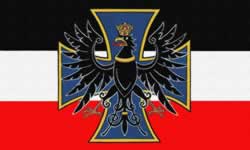 PRUSSIAN EMPIRE
PRUSSIAN EMPIRE
Gustav Class Bombard Monitor (Large Class) (Unit Size 1)
The Gustav Class Bombard Monitor provides a stable naval firing platform for one of the most terrifying artillery pieces available to the Prussian Empire; the PAK-800 KYC, often referred to by its gun crews as the Todesengel, or Angel of Death.
The PAK-800 KYC was primarily developed for ground operations by the Reichswehr, transported on railway tracks and used as a siege weapon on the Eastern Front against static fortifications and large, slow-moving targets like the infamous Russian and Commonwealth Land Dreadnoughts. Even the mightiest opponents can be shattered by a sustained pounding from these enormous weapons.
The Gustav is based upon an older pre-Sturginium Age blue-water cargo barge, but the design has been heavily recast to turn it into a true warship. The massive bombard (dragged on to the ship by its own train!) itself is of limited utility at short ranges, and so the vessel mounts clusters of Tesla projectors fore and aft for close defence. In an unexpected move by the Teutonic Order engineers, the Gustav additionally fields experimental Tesla Torpedo launchers in lieu of standard broadsides.
These unique munitions are intended to dissuade submerged enemies that might seek to engage the vessel prior to its main ordnance being fired. The impact of a live high-yield electrical generator on a fully submerged ship is dramatic indeed. The sheer energy discharge is capable of twisting open solid steel plates and burning crewmembers to a crisp even deep within the enemy’s hull as many metal surfaces temporarily becomes ‘live’!
Brandtaucher Class Submarine (Medium Class) (Unit size 1-3)
The Brandtaucher or Fire-Diver submersible is a cutting-edge underwater attack craft newly in service with the Prussian Empire’s Iron Fleets. Entering service in late 1873, initially with the northern fleet detachments, it is the spiritual successor of the infamous craft used during the London Raid.
This aggressive warship is purposely designed to employ stealth to approach the enemy undetected, before unleashing a storm of gunnery and elite assault troops. Its brace of forward cannons hammer the enemy with explosives and electrical burst munitions, before a wave of crack Luftlancers and aquanauts pours into the shattered target to overwhelm its defenders.
Brandtaucher squadrons, nicknamed ‘Packs’ by Iron Fleet commanders, specialise in surprise assaults, known with grim humour among their elite officer corps as ‘shock therapy’. Stalking a choice target, their captains patiently wait until the right moment to rain hell upon the hapless foe, before executing a clean getaway. And should any pursuit be forthcoming, the lethal clusters of mines left in the submarines’ wake are more than enough to dissuade all but the most foolhardy.
Lahn Class Destroyer (Small Class) (Unit size 2-4)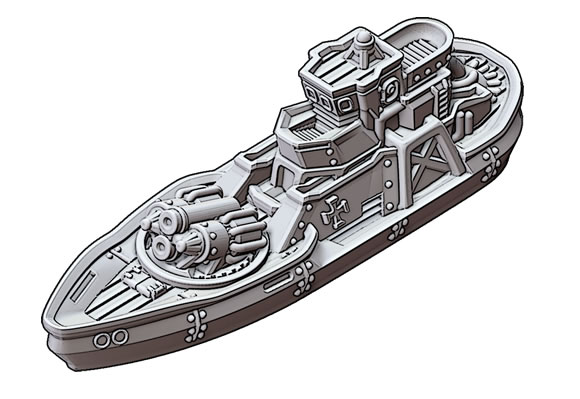 Operating a considerable distance from home base, as some of their flotillas did in the Caribbean, and latterly along the African coast, brought home the need for swift anti-air cover for the Iron Fleets. The Prussian answer to this problem is the Lahn, the latest of the Imperial Naval command’s light but well-armed destroyer designs.
Operating a considerable distance from home base, as some of their flotillas did in the Caribbean, and latterly along the African coast, brought home the need for swift anti-air cover for the Iron Fleets. The Prussian answer to this problem is the Lahn, the latest of the Imperial Naval command’s light but well-armed destroyer designs.
Utilising the deadly Speerschleuder electro-lance launcher and powerful Tesla turbine engines, the Lahn is a deadly hunter. Commanded by self-reliant captains, Lahn squadrons are given a free-roaming role in naval orders of battle, seeking out and destroying enemy aerial threats of all kinds.
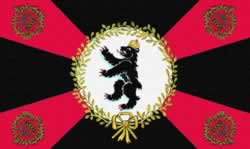 RUSSIAN COALITION
RUSSIAN COALITION
Magadan Class Submarine (Large Class) (Unit size 1)
The Magadan Large Submarine, also known as the Oktober Class by its crew due to the month it first set sail in 1875, provides a strong naval artillery presence for the Russian Coalition, allowing for coastal bombardments without the need for close range engagement.
The launch of the first example at Kronstadt was a grand affair, attended by the Tsar himself. The Magadan was the end product of the revived ‘Proyeckt Pobeda 2’ – Victory Project 2 – painstakingly recreated after ‘Black Wolf’ Nikonov’s treachery all but destroyed the first nearly a decade earlier.
The Magadan is a deep-diving bombardment vessel, designed after reports of French submarine artillery reached the White Navy command in 1872. This huge vessel is armed with an array of large calibre heavy mortars. A surfacing Magadan is a terrifying sight, breaking the frothing waves like an oceanic beast of legend, before vomiting fire and steel upon its targets.
In a key design move, the Magadan is the first Russian naval vessel to be fitted with experimental torpedo launchers which give it a decisive offensive capability against enemy submarines. Persistent rumours state that Prince Andrei ‘the Axe’, commander of the Oprichnina, insisted upon the inclusion of these weapons in the final design; the better to send the infamous Black Wolf to a watery grave should his path ever cross with one of these ‘Baltic Sea Monsters’.
Onega Class Light Cruiser (Medium Class) (Unit size 2-4)
The Onega Class Light Cruiser provides Russian Coalition Fleet Commanders with a low draft medium class vessel perfectly suited to engage multiple small enemy targets at once. The initial design was a product of the Far East Fleet’s naval architects, following the final lifting of the siege of Vladivostok in 1874.
The Light Cruiser design is a novel concept for the White Navy, where the ‘bigger is better’ philosophy has long dominated. Its array of weaponry makes it a good ‘all-rounder’, perfect for patrolling the vital yet vulnerable sea routes between the Russian Far East and Alaska Oblast.
Though relatively small, the Onega punches well above its weight, with turret and high-angle bombardment batteries used to despatch all enemies. It is also equipped with an excellent underwater detection system, courtesy of massed concussion charge throwers. These make the ship an excellent sub-hunter, even against the underwater behemoths of the Blazing Sun, and have earned it the nickname Ubiytsa Monstrov – ‘Monster Hunter’ – among its crews.
Mezan Class Gun Corvette (Small Class) (Unit size 2-5)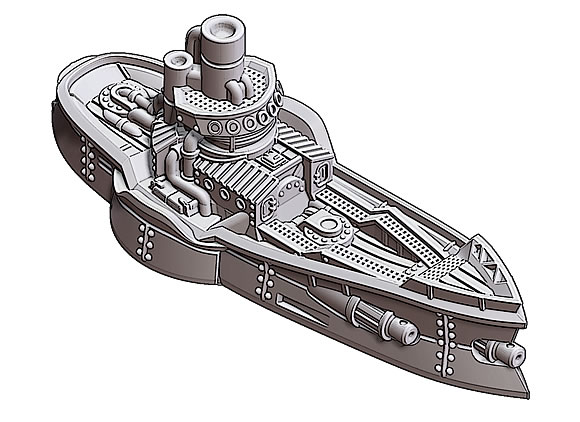 First built at opposite ends of the vast Russian Coalition, in the Alaska Oblast and the Grand Duchy of Finland, the Mezan began life as a field modification of the Kazimov Corvette. Mounting a battery of guns adapted from White Army artillery pieces created a small but powerful gunboat. By mid-1875 the design had been officially recognised and was being produced in all major Russian naval yards.
First built at opposite ends of the vast Russian Coalition, in the Alaska Oblast and the Grand Duchy of Finland, the Mezan began life as a field modification of the Kazimov Corvette. Mounting a battery of guns adapted from White Army artillery pieces created a small but powerful gunboat. By mid-1875 the design had been officially recognised and was being produced in all major Russian naval yards.
Mezen Gun Corvette Squadrons stalk the seaways around the Russian Coalition from the Baltic to the Aleutians, hunting for enemy shipping with feral abandon. Such is their toll on Imperial Bond merchant vessels that all Bond power aerial fleets have a standing sink-on-sight order in place for these White Navy reavers of the waves.
Watch out for more exciting updates!


